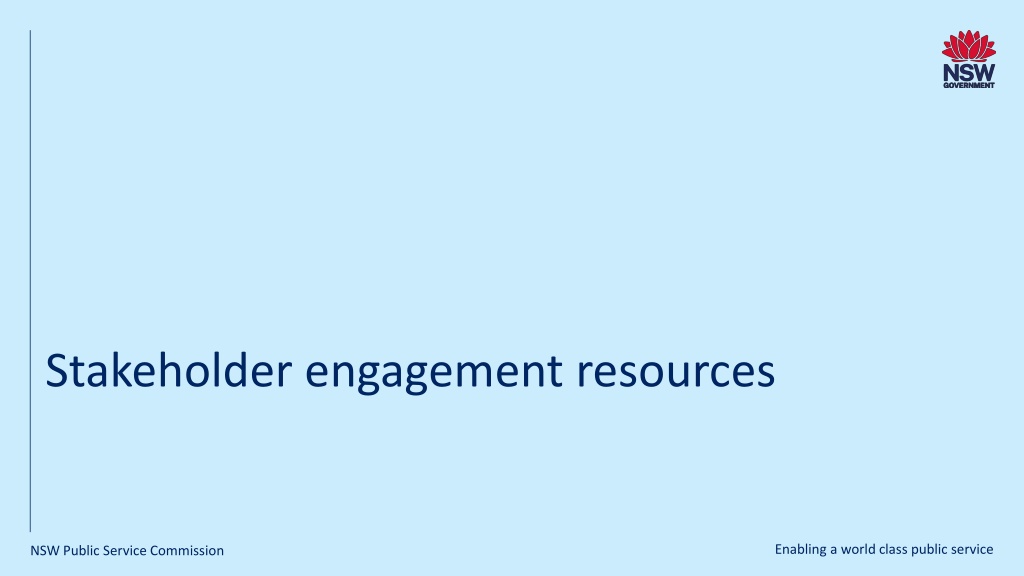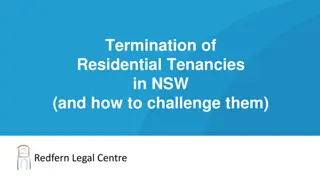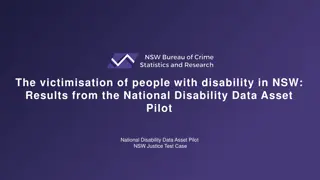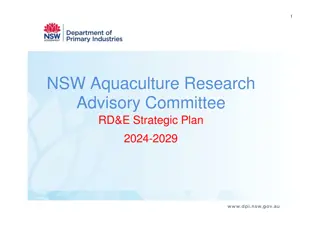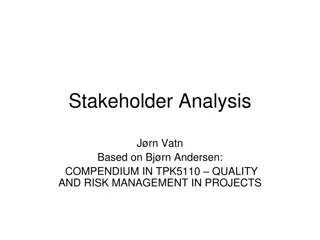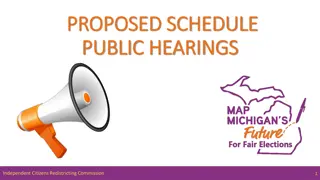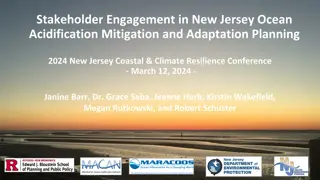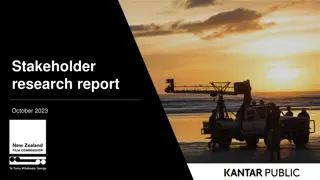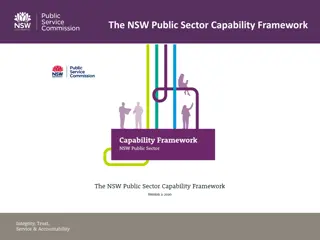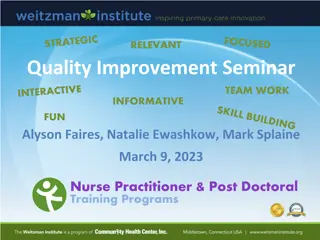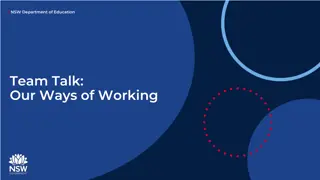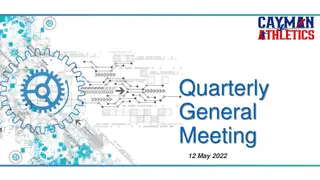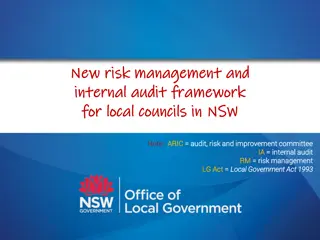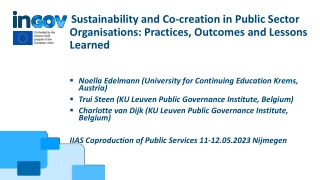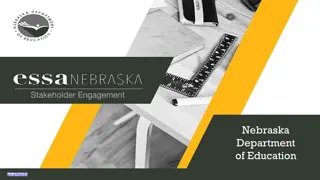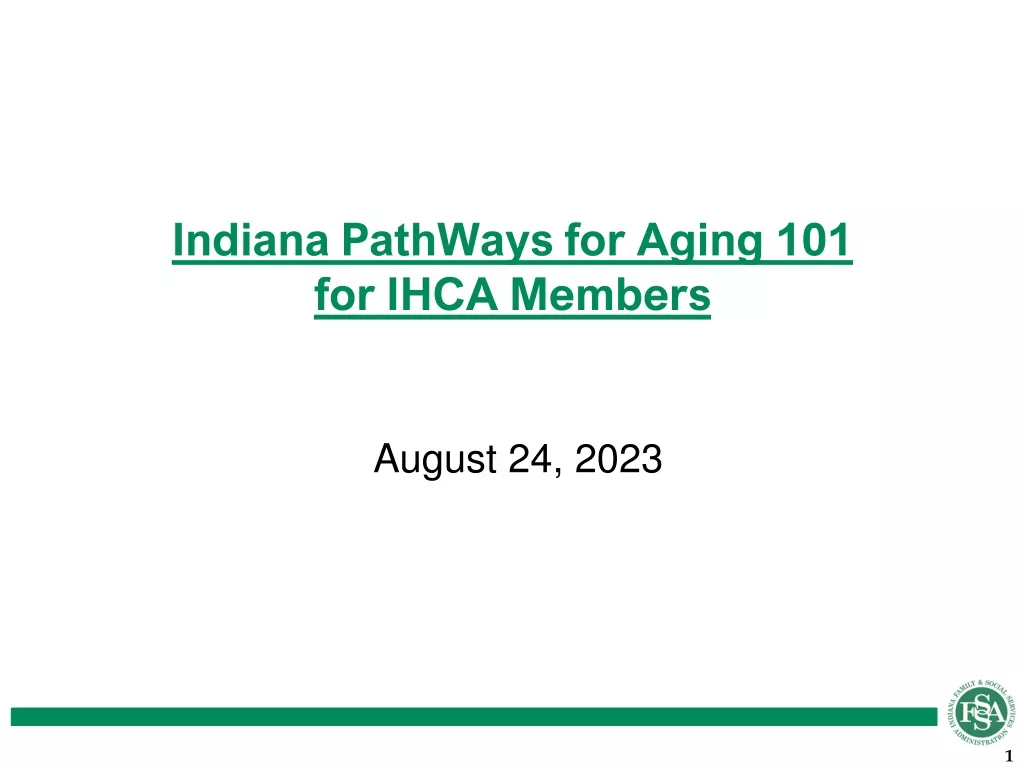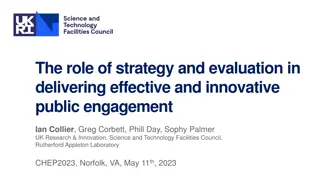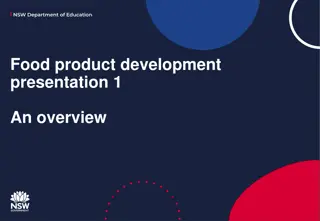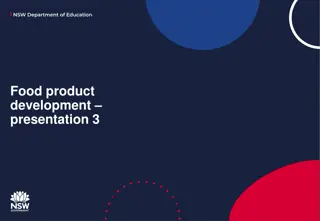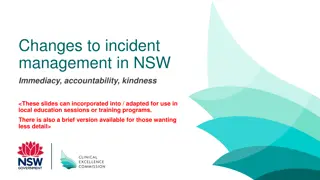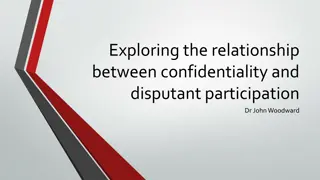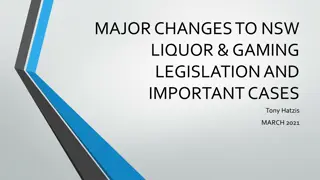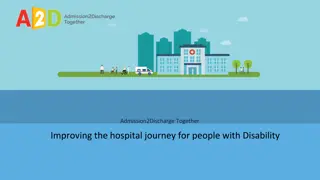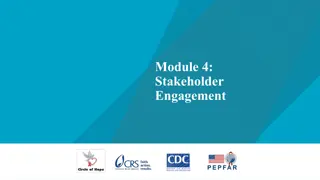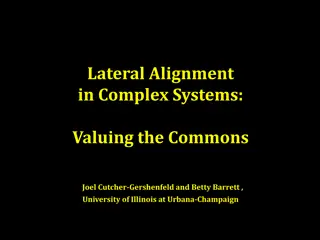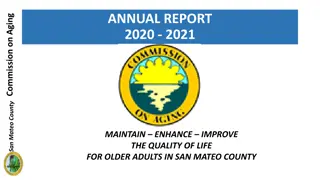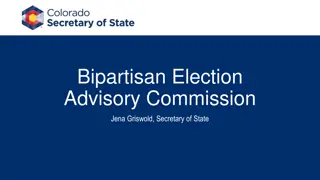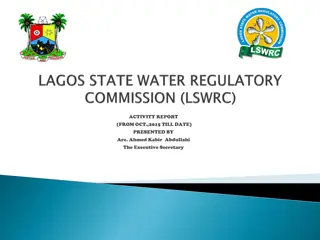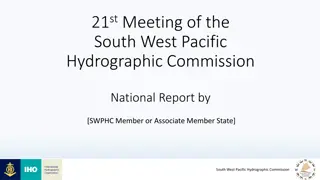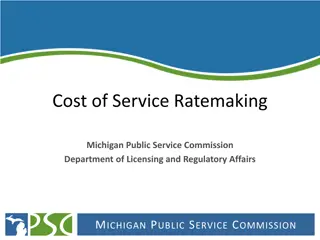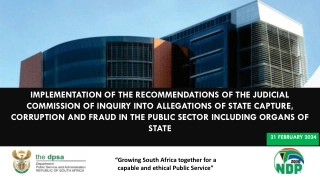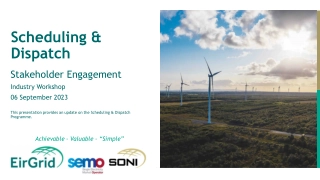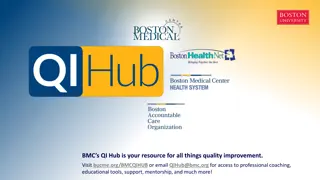Effective Stakeholder Engagement in NSW Public Service Commission
This resource provides valuable tools and principles for stakeholder engagement within the NSW Public Service Commission. It covers stakeholder identification, understanding, and engagement processes, emphasizing the importance of collaboration, transparency, and respect. By following the outlined principles and utilizing the provided templates, organizations can enhance decision-making, minimize risks, and foster trust among stakeholders, ultimately leading to a more successful restructuring process.
Download Presentation

Please find below an Image/Link to download the presentation.
The content on the website is provided AS IS for your information and personal use only. It may not be sold, licensed, or shared on other websites without obtaining consent from the author. Download presentation by click this link. If you encounter any issues during the download, it is possible that the publisher has removed the file from their server.
E N D
Presentation Transcript
Stakeholder engagement resources Enabling a world class public service NSW Public Service Commission
Stakeholder engagement tools Stakeholder engagement principles This resource lists the benefits of involving stakeholders and the fundamental principles of engaging them effectively. 01 02 Stakeholder engagement process This process outlines the key steps needed to identify and understand your stakeholders and plan your approach to engage. Understanding your stakeholders This tool lists key questions that will help you understand the needs, expectations, and influence of your stakeholder groups. 03 RASCI Matrix This matrix will help you identify who needs to be responsible, accountable, supported, consulted and informed. 04 Stakeholder engagement plan This template will help you plan how you will engage your stakeholders throughout a restructure. 05 NSW Public Service Commission Enabling a world class public service 2
Stakeholder engagement principles Throughout the organisation redesign process, you will need support from everyone involved in the process including leaders, all levels of management and the workforce. Once you ve identified your key stakeholders, you can customise the way you engage and involve them in the process. In a restructure, the employees are your primary stakeholder group. Benefits of stakeholder engagement include: Better understanding of your organisation s complex operating environment Better decision making that involves all areas of the business Minimises risks and provides better reputation management Increases employee engagement and opportunities for employee voices to be heard Builds trust between the employees, senior leaders and the organisation Identify your stakeholder engagement objectives and what you want to achieve. Establish a clear purpose. 01 ENGAGEMENT STAKEHOLDER PRINCIPLES Be open, honest and transparent when engaging with stakeholders. Be transparent. 02 Work in collaboration and partnership with your stakeholders. Collaborate with others. 03 Acknowledge and respect the diverse perspectives and needs of others. Acknowledge and respect others. 04 NSW Public Service Commission Enabling a world class public service 3
Stakeholder engagement process 1. IdentifyIdentify your Understanding your stakeholders tool Using the RASCI matrix template, identify the level of engagement needed (responsible, accountable, supported, consulted and informed) throughout the organisation redesign process 2. DefineDefine your stakeholder meetings, town halls, focus groups, facilitated consultation sessions etc) 3. EngageEngage your stakeholders Stakeholder engagement plan if there is stakeholder resistance and difficulty with engaging certain stakeholder groups. Seek further advice from your communications team if needed. stakeholders needs and the level of engagement required engagement plan Complete the Stakeholder engagement plan template to identify which stakeholders you will need to engage and what engagement methods you will need to use (e.g. emails, Refer to your Stakeholder engagement plan throughout the organisation redesign process and be accountable for the action items listed in your plan Revise and review your Define your stakeholder engagement objectives Identify your stakeholders needs, expectations and what s important to them by completing the NSW Public Service Commission Enabling a world class public service 4
Understanding your stakeholders Who are our stakeholders? Stakeholders are any group or individual affected by an organisation, its objectives, operations and/or decisions. Stakeholders may have a direct or indirect role in an organisation s processes, projects or initiatives. Stakeholder Stakeholder description What are their needs and expectations? What s important to them? What is their willingness to engage (supportive, marginal, unsupportive)? What is their level of influence (low, medium, high)? What is their current knowledge of the change? What is the impact of the change on each stakeholder group? Human Resources HR team responsible for partnering with leaders and client groups to manage and implement the change Key decision maker Key decision maker(s) driving the change or delegated authority accountable for the change Senior leaders This may include senior leaders impacted by the proposed change or all senior leaders in the organisation People managers People managers with management responsibilities Business Managers and key subject matter experts (SMEs) across the organisation who can provide contextual information and a helicopter view of the organisation (e.g. Finance, Legal, ICT, communications etc) NSW Public Service Commission Enabling a world class public service 5
Understanding your stakeholders (cont.) Stakeholder Stakeholder description What are their needs and expectations? What s important to them? What is their willingness to engage (supportive, marginal, unsupportive)? What is their level of influence (low, medium, high)? What is their current knowledge of the change? What is the impact of the change on each stakeholder group? Affected staff Impacted staff excluding contractors Other staff Staff who work closely with the impacted staff members affected by the change, excluding contractors Contractors Impacted staff employed as contractors Customers Clients and customers that may be directly or indirectly impacted by the change Unions Unions include the Public Service Association of NSW and Community and Public Sector Union (SPSF Group) NSW Branch and other unions Project team Project team established to manage and implement the change Change champions Staff in the organisation who champion the change External consultants External consultants hired by the organisation to work on the proposed change or other projects NSW Public Service Commission Enabling a world class public service 6
RASCI template Goal Steps Responsible Who is responsible for action, implementation and project completion? Accountable Who has control over the project and resources and is ultimately accountable for project outcomes and deliverables? Supported Who will provide support and assistance to the responsible members? Consulted Who will provide input or give advice to the responsible members (two way communication) Informed Who needs to be informed of the progress of the activity (one way communication)? Stage 1: Explore Explore organisational needs to identify if a restructure is the right solution Identify if restructuring is the right solution by having an exploratory discussion Stage 2: Plan Plan the approach Plan how you will approach the restructure Identify ways to resource and deliver the change Identify how you will engage each stakeholder group Stage 3: Scope Identify the objectives, scope and desired outcomes for the restructure Identify the objectives, scope and desired outcomes for the restructure Set the direction for your design decisions by identifying design principles using the building blocks NSW Public Service Commission Enabling a world class public service 7
RASCI template (cont.) Goal Steps Responsible Who is responsible for action, implementation and project completion? Accountable Who has control over the project and resources and is ultimately accountable for project outcomes and deliverables? Supported Who will provide support and assistance to the responsible members? Consulted Who will provide input or give advice to the responsible members (two way communication) Informed Who needs to be informed of the progress of the activity (one way communication)? Stage 4: Design Develop the design which considers workforce transition & managing excess employees guidelines and lists changes to the organisation structure, role design, ways of working, processes, systems and delegations. Develop the high-level organisational design Develop the detailed organisation design Develop the implementation plan and consult staff and unions. Develop the implementation plan Stage 5: Implement Implement the new structure using the outputs from the Identify and Design stages Collatethe organisational design and implementation plan (outputs from the Identify and Design stages) NSW Public Service Commission Enabling a world class public service 8
RASCI template (cont.) Responsible Who is responsible for action, implementation and project completion? Accountable Who has control over the project and resources and is ultimately accountable for project outcomes and deliverables? Supported Who will provide support and assistance to the responsible members? Consulted Who will provide input or give advice to the responsible members (two way communication) Informed Who needs to be informed of the progress of the activity (one way communication)? Goal Steps Conduct final consultation with unions and staff and incorporate any changes to the organisation redesign Implement the new structure using the outputs from the Identify and Design stages Stage 5: Implement Gain final endorsement on the organisation design and approval from leadership to implement the change Evaluate the success of the restructure by reflecting on the objective and goals of the restructure, and the effectiveness of the redesign process. Monitor and evaluate the success of the restructure Assess if the new design is working effectively and revise as needed Stage 6: Embed Document lessons learned and any effective resources/templates used for future change activities Communicate the outcomes of the evaluation to staff NSW Public Service Commission Enabling a world class public service 9
RASCI matrix example When you are completing the RASCI matrix, keep in mind the context of your organisation, your organisation redesign approach, relevant industrial frameworks and any obligations arising from the Consultative Arrangements Policy and Guidelines (where applicable). Here is an example of a completed RASCI matrix which emphasises a collaborative approach to planning and delivering a restructure. Responsible Who is responsible for action, implementation and project completion? Accountable Who has control over the project and resources and is ultimately accountable for project outcomes and deliverables? Supported Who will provide support and assistance to the responsible members? Consulted Who will provide input or give advice to the responsible members (two way communication) Informed Who needs to be informed of the progress of the activity (one way communication)? Goal Stage 1: Explore Explore organisational needs to identify if a restructure is the right solution HR team / consultants HR Key decision maker Senior leaders Unions HR team / consultants Stage 2: Plan Plan how you will approach the restructure HR Key decision maker Senior leaders Affected staff Stage 3: Scope Identify the objectives, scope and desired outcomes for the restructure HR team / consultants HR Key decision maker Senior leaders Affected staff NSW Public Service Commission Enabling a world class public service 10
RASCI matrix example When you are completing the RASCI matrix, keep in mind the context of your organisation, your organisation redesign approach, relevant industrial frameworks and any obligations arising from the Consultative Arrangements Policy and Guidelines (where applicable). Here is an example of a completed RASCI matrix which emphasises a collaborative approach to planning and delivering a restructure. Responsible Who is responsible for action, implementation and project completion? Accountable Who has control over the project and resources and is ultimately accountable for project outcomes and deliverables? Supported Who will provide support and assistance to the responsible members? Consulted Who will provide input or give advice to the responsible members (two way communication) Informed Who needs to be informed of the progress of the activity (one way communication)? Goal HR team / consultants Develop the high-level organisational design HR Senior leaders Business Affected staff HR team / consultants Stage 4: Design Develop the detailed organisation design HR Senior leaders Business Affected staff Business Unions Affected staff Unions Develop the implementation plan (including the change and communication plans) HR team / consultants HR Key decision maker Senior leaders Unions Stage 5: Implement Implement the new structure using the outputs from the Identify and Design stages HR team / consultants HR Senior leaders People managers Affected staff Stage 6: Embed HR team / consultants Monitor and evaluate the success of the restructure HR Key decision maker Affected staff Affected staff NSW Public Service Commission Enabling a world class public service 11
Stakeholder engagement plan Use the below stakeholder engagement template to identify which stakeholders you will need to engage and what message needs to be communicated throughout the organisation redesign process. Stage: Explore Plan Scope Design Implement Embed Stakeholder group (name the individual or group) Engagement approach Consult (request for input, feedback or advice) Inform (provide updates on the progress of the activity) Involve (inform and provide opportunity for participation) Collaborate (proactively collaborate and engage) Communication channel Townhall meeting Meetings Workshops Intranet Email Intranet Frequency Daily Weekly Monthly Quarterly As required Key messages Who What Where When How Responsible (name the individual or group) Risks and mitigation strategies Low Medium High Notes Example: Design stage Example: Finance & Investment Delivery Branch Example: Consult affected staff Example: Townhall meeting Example: 1 November 2022 Example: the rationale of the change, who will be affected and when the change will take effect Example: Human resources Example: Medium NSW Public Service Commission Enabling a world class public service 12
